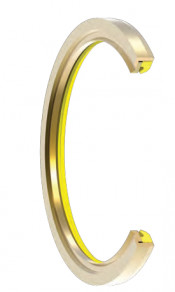- Home » Editorial » Hydraulics
The evolving role of ice wipers in hydraulic systems

Originally designed to remove ice from hydraulic piston rods, ice wipers now play a crucial role in preventing dirt, wear, and contamination. Advanced designs offer durability and adaptability for demanding environments, ensuring reliable performance across industries such as steel production, recycling, and offshore applications. H&P reports.
Ice wipers for hydraulic cylinders are named after their original purpose, i.e. to remove layers of ice or frost from extended piston rods in low-temperature applications. However, such components are increasingly faced with other challenges and it is not uncommon to experience completely torn polymer wipers or bent and destroyed brass wiper lips. Such damage results in ingress of dirt and particles with fatal consequences for the underlying sealing and guide system. The resulting follow up costs for removal, maintenance or overhaul and reinstallation of a hydraulic cylinder destroyed by particle ingress can often exceed the original
value of a newly delivered cylinder, not to mention downtime. In areas where machines and hydraulic cylinders are continuously exposed to enormous dirt loads, it is essential that attention is paid to the wiper system and that it is adapted as precisely as possible to these conditions.
In applications where standard wipers made of elastomers such as NBR or TPEs reach their limits for reasons of strength and wear, so-called metal wipers must be used. Hunger Hydraulic’s wiper type A EIS-SL is a robust solution that has been used successfully for many years.
A radially floating primary wiper edge located in the outer retaining ring and designed with clearance is able to follow a piston rod deflected under bending and transverse load and reliably remove even tough or firmly adhering contaminants such as scale, slag spatter, welding beads and even layers of lime from the rod surface. Such harsh conditions are seen in: steel or aluminum plants, in waste compactors, scrap & recycling sectors and often pose major problems for conventional wiper systems.
In the standard version of the A-EIS-SL, the primary wiper edge is made of bronze. However, depending on the application, this can also be made of other metallic or polymer materials. Hunger Hydraulic determines the respective design of the components individually depending on the application and the operating parameters of the cylinder.
For example, stainless steel versions are available for the retaining and primary wiper ring for food applications (e.g. agitators, dosing and feed cylinders) as well as highly corrosion-resistant duplex steels for underwater or offshore applications. Suitable metallic materials can also be offered for use in high-temperature applications such as steel foundries.
The secondary wiper lip arranged after the primary edge, usually consists of an elastic material which prevents the penetration of dust, very fine residual dirt films or moisture. The materials used for the guide and sealing system (behind the wiper) are thus reliably protected from contamination from harmful fluids (e.g. solvents, water, etc.) or abrasive fine particles.
Hunger Hydraulic can also adapt the secondary lip to the different conditions in the application. In the standard version, TPU’s and TPE’s are available in various degrees of hardness and designs (e.g. hydrolysis and microbe-resistant) or vulcanized NBR versions. FKM, H-NBR and FVMQ are available for high-temperature applications. For applications in the low temperature sector, Hunger Hydraulic has a special NBR compound in its portfolio, which can be used down to - 54°C.
Wipers for applications where high travel speeds (>1m/s) are achieved, or where extreme demands are placed on chemical resistance and a wide temperature range can be fitted with secondary lips made of corresponding PTFE compounds or high-performance plastics (e.g. PEEK). Depending on the material combination, applications and temperature ranges from -60°C to +200°C can be covered.
Following design and material optimization of individual components, Hunger Hydraulic can offer wiper systems that are tailored to function, performance and operating conditions in dimensions from Ø8mm to Ø950mm.
For more information please visit: www.hunger-dichtungen.de/home
-
SMART Manufacturing & Engineering Week
04 - 05 June, 2025
NEC, Birmingham UK -
PPMA 2025
23 September, 2025, 9:30 - 25 September, 2025, 16:00
NEC, Birmingham UK -
Advanced Engineering Show 2025
29 October, 2025, 9:00 - 30 October, 2025, 16:00
NEC, Birmingham UK










